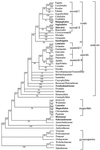The role of genetic and genomic attributes in the success of polyploids
- PMID: 10860970
- PMCID: PMC34383
- DOI: 10.1073/pnas.97.13.7051
The role of genetic and genomic attributes in the success of polyploids
Abstract
In 1950, G. Ledyard Stebbins devoted two chapters of his book Variation and Evolution in Plants (Columbia Univ. Press, New York) to polyploidy, one on occurrence and nature and one on distribution and significance. Fifty years later, many of the questions Stebbins posed have not been answered, and many new questions have arisen. In this paper, we review some of the genetic attributes of polyploids that have been suggested to account for the tremendous success of polyploid plants. Based on a limited number of studies, we conclude: (i) Polyploids, both individuals and populations, generally maintain higher levels of heterozygosity than do their diploid progenitors. (ii) Polyploids exhibit less inbreeding depression than do their diploid parents and can therefore tolerate higher levels of selfing; polyploid ferns indeed have higher levels of selfing than do their diploid parents, but polyploid angiosperms do not differ in outcrossing rates from their diploid parents. (iii) Most polyploid species are polyphyletic, having formed recurrently from genetically different diploid parents. This mode of formation incorporates genetic diversity from multiple progenitor populations into the polyploid "species"; thus, genetic diversity in polyploid species is much higher than expected by models of polyploid formation involving a single origin. (iv) Genome rearrangement may be a common attribute of polyploids, based on evidence from genome in situ hybridization (GISH), restriction fragment length polymorphism (RFLP) analysis, and chromosome mapping. (v) Several groups of plants may be ancient polyploids, with large regions of homologous DNA. These duplicated genes and genomes can undergo divergent evolution and evolve new functions. These genetic and genomic attributes of polyploids may have both biochemical and ecological benefits that contribute to the success of polyploids in nature.
Figures


References
-
- Stebbins G L. Variation and Evolution in Plants. New York: Columbia Univ. Press; 1950.
-
- Stebbins G L. Chromosomal Evolution in Higher Plants. London: Edward Arnold; 1971.
-
- Stebbins G L. Adv Genet. 1947;1:403–429. - PubMed
-
- Masterson J. Science. 1994;264:421–423. - PubMed
-
- Grant V. Plant Speciation. 2nd Ed. New York: Columbia Univ. Press; 1981.
LinkOut - more resources
Full Text Sources
Other Literature Sources

